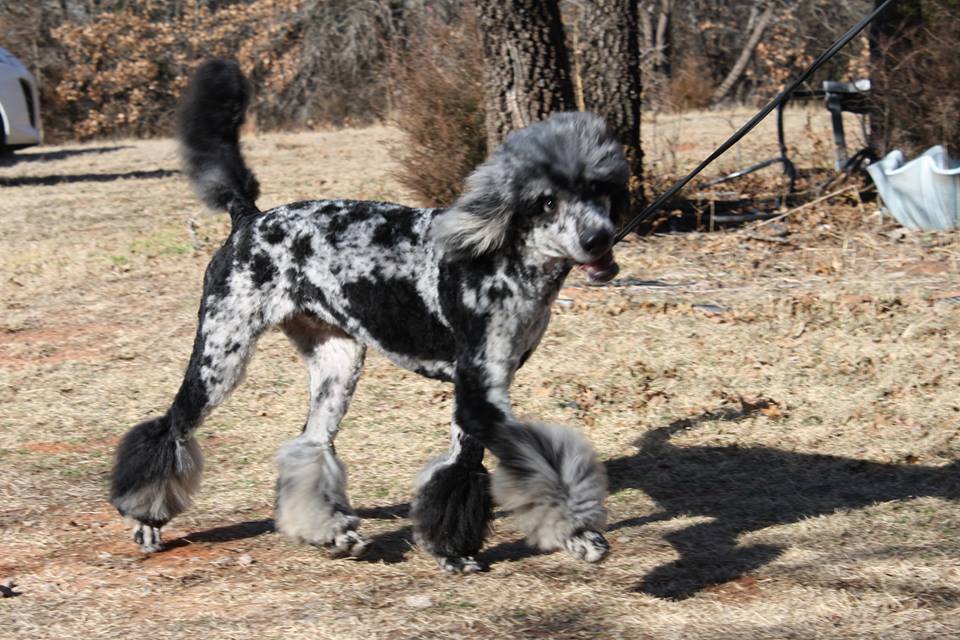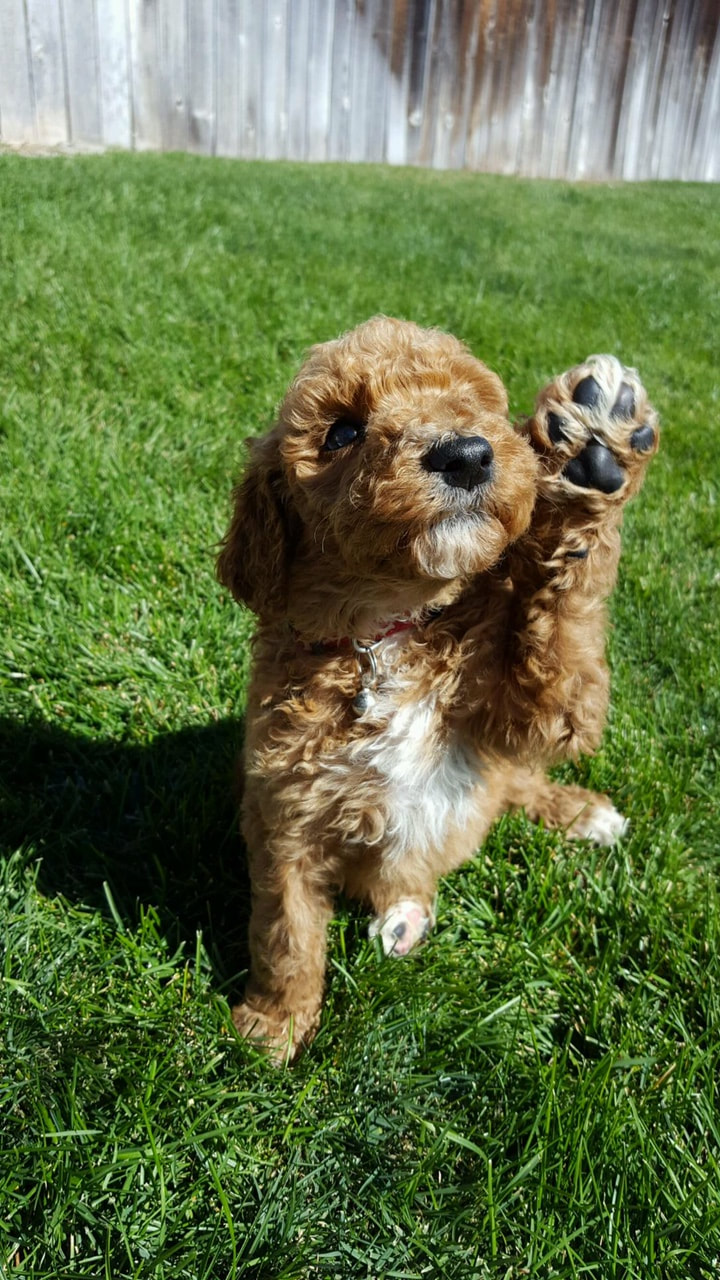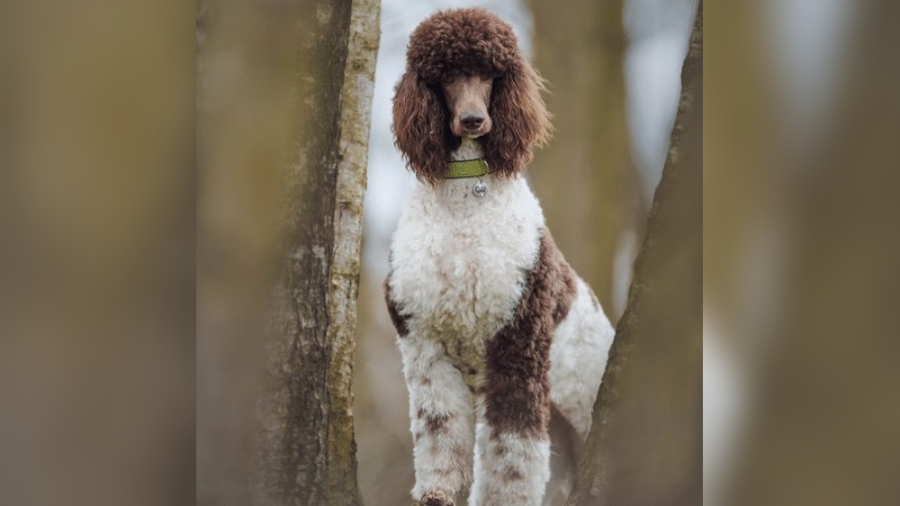Have you ever wondered if poodles can sport more than one color on their coats? If you’re drawn to these elegant dogs but crave something unique and eye-catching, you might be curious about the variety of colors poodles can have.
From classic solid shades to striking multi-colored patterns, poodles offer a surprising range that many don’t realize. You’ll discover whether poodles can truly be multicolored, what those colors mean, and how rare some patterns are. Keep reading to find out how your perfect poodle might just stand out in a crowd with a coat that’s as vibrant and distinctive as they are!

Poodle Color Basics
Poodles can have multiple colors, often seen in patterns like parti or tricolor. These blends create unique and eye-catching coats. Some markings appear on the face or legs, adding to their charm.
Poodles have a wide range of coat colors. These colors can be solid or mixed. Understanding basic poodle colors helps in recognizing if they can be multicolored.
Each poodle’s color is determined by its genes. Some colors appear more often than others. Colors also vary by poodle size and breed type.
Common Solid Colors
Many poodles have solid coats. Black is the most common solid color. Other solid colors include white, apricot, red, and brown. These colors are rich and consistent across the coat.
Multicolored poodles show two or more colors on their coat. Parti poodles have large patches of two colors. Phantom poodles have markings on the face and legs, creating a multicolored look. These patterns are less common but very popular.
Rare And Unique Colors
Some poodle colors are rare. Apricot is one of the rarest colors due to its genetic makeup. Silver and café-au-lait are also uncommon. These colors may fade or change as the dog ages.
Common Poodle Colors
Poodles come in many beautiful colors. These colors show the breed’s diversity and charm. Understanding common poodle colors helps you recognize them easily. Each color has unique traits and appeal. Some colors are more popular, while others are rare and special.
Black Poodles
Black is a classic and common poodle color. It looks shiny and rich on the coat. Black poodles often have dark eyes and noses. This color stays vibrant and does not fade easily. Many people love black poodles for their elegant look.
White Poodles
White poodles have a pure, snowy coat. Their fur looks soft and bright. White is another popular color among poodle owners. These dogs may need extra grooming to keep their coat clean. White poodles stand out with their striking appearance.
Apricot And Red Poodles
Apricot poodles have a warm, light orange shade. This color is rare and needs a special gene. Red poodles are deeper in color and rich like rust. Both apricot and red can fade with time or sun exposure. Many find these colors charming and unique.
Silver And Gray Poodles
Silver poodles have a soft, metallic gray coat. Gray poodles come in various shades from light to dark. These colors can give a poodle a sleek, modern look. Silver and gray are less common but very attractive colors. Their coats may change slightly as they age.
Brown And Cafe Au Lait Poodles
Brown poodles have a warm chocolate coat. Cafe au lait means “coffee with milk” and is a light tan color. Both colors are less common and very appealing. Brown shades often come with matching noses and eyes. These colors add variety to the poodle family.
Parti And Multicolored Poodles
Parti poodles have two or more colors in patches. These patches usually include white with another shade. Multicolored poodles can have patterns like spots or splashes. This unique coloring makes each poodle one of a kind. Multicolored coats are fun and eye-catching.
Rare Poodle Shades
Some poodle colors appear very rarely in litters. These rare shades attract many dog lovers. They offer a unique look that stands out from common colors like black or white.
Rare poodle shades come from specific genes. These genes are less common and need both parents to carry them. This makes the colors hard to find and special.
Apricot is one of the rarest poodle colors. It looks like a soft pale red with a pinkish tint. Both parents must carry the apricot gene for puppies to have this color.
Apricot poodles often fade in color over time. Sunlight can make their coat lighter. This fading makes it tricky to keep their true vibrant shade.
Silver Poodles
Silver poodles have a shiny gray coat with a slight blue tone. This color is not a separate breed but is rare. The silver shade comes from a dilution gene affecting black or brown coats.
Many silver poodles have a soft, smooth coat that looks very elegant. Their unique shade makes them popular among those wanting something different.
Cafe Au Lait Poodles
Cafe au lait means “coffee with milk” in French. This rare color is a light tan or creamy brown. It results from a fading gene in some brown poodles.
These poodles have a warm, gentle appearance. Their color can change slightly with age, adding to their charm.
Parti-colored Poodles
Parti poodles have coats with two or more colors. Usually, one color is white with patches of another color. This pattern is rare and eye-catching.
Common parti colors include white mixed with black, brown, or apricot. Each dog’s pattern is unique, making them very special.
Apricot Poodles
Apricot Poodles are one of the rarest and most charming Poodle colors. Their coat shows a soft, warm shade that blends pale red and pink tones. This unique color makes them stand out in a crowd of more common Poodle colors. Many dog lovers and breeders prize apricot Poodles for their gentle, appealing hue.
These Poodles need special attention to keep their color bright. The apricot shade can change over time, making care and genetics key factors in their appearance. Understanding these elements helps owners appreciate the beauty and rarity of apricot Poodles.
Genetic Factors
The apricot color comes from a recessive gene. Both parents must carry this gene for the puppy to have apricot fur. This genetic requirement makes apricot Poodles uncommon. Breeders often test the parents to predict if apricot puppies will be born.
This gene reduces the intensity of the brown color, giving apricot Poodles their soft pinkish-red shade. Without both parents passing the gene, the apricot color cannot appear. This genetic rarity adds to the charm and uniqueness of apricot Poodles.
Color Fading Issues
Apricot Poodles often experience color fading as they age. Sunlight can bleach their coats, making the apricot shade lighter or duller. This fading happens because the color pigments are delicate and sensitive to light.
Owners must protect their Poodles from strong sun exposure to maintain the coat color. Regular grooming and gentle care also help keep the apricot shade vibrant. Despite these efforts, some fading is natural and common with apricot Poodles.
Multicolored Patterns
Poodles can show a variety of multicolored patterns. These patterns add to their charm and uniqueness. Many poodle lovers admire these colors for their striking appearance. Each pattern has its own special look and genetic background.
These multicolored coats are not just beautiful but also tell a story about the dog’s breed and heritage. They come in different styles and shades, making every poodle one of a kind.
Parti Poodles
Parti poodles have a coat with two or more colors. The base color is usually white with large patches of another color. Common patch colors include black, brown, or apricot. The patches can be random and create a playful look. Parti poodles are easy to recognize because of their bold spots.
Phantom Markings
Phantom markings appear as distinct spots on the face, legs, and chest. These markings look like shadows, giving the poodle a unique appearance. The main coat color is darker, with lighter “phantom” patches. This pattern often resembles the markings of a Doberman. Phantom poodles stand out with their elegant, mask-like features.
Sable And Brindle
Sable poodles have hairs with multiple colors on each strand. This gives their coat a shaded or blended look. The base is usually light with darker tips. Brindle poodles show stripes or streaks of darker colors over a lighter base. These stripes create a tiger-like pattern. Both sable and brindle patterns make poodles look wild and beautiful.
Tricolor Poodles
Tricolor Poodles display a unique and eye-catching coat pattern. These dogs have three distinct colors on their fur. This pattern is rare and special among Poodles. The combination creates a lively and charming look that many dog lovers admire.
Tricolor Poodles often have a base color combined with two other shades. The colors usually appear in specific areas like the face, legs, and chest. This adds depth and contrast to their appearance. Their coat colors can include black, white, and tan, or other mixes depending on genetics.
What Are Phantom Markings?
Phantom markings are a key feature of tricolor Poodles. These markings look like small patches or spots on the face and legs. They are usually a darker shade than the main coat color. This effect gives the dog a striking and distinctive look.
How Do Tricolor Poodles Differ From Parti Poodles?
Parti Poodles have two or more colors in large patches across their body. Tricolor Poodles combine the parti pattern with phantom markings. This means a tricolor Poodle can have white legs like a parti, plus extra color spots on the face. This mix makes tricolor coats more complex.
Common Color Combinations In Tricolor Poodles
Black, white, and tan is the most common tricolor mix. Another popular combo is brown, cream, and tan. These colors create a beautiful contrast that highlights the dog’s features. Some tricolor Poodles may also show shades of gray or apricot in their coat.
Genetics Behind Tricolor Poodles
Tricolor patterns result from specific gene combinations. The genes control how colors spread and where phantom markings appear. Breeders select dogs with the right genes to produce tricolor puppies. This makes tricolor Poodles less common than solid or parti-colored ones.
Rainbow Poodles Trend
The Rainbow Poodles trend has captured the attention of dog lovers worldwide. These colorful poodles stand out with their bright, eye-catching coats. Groomers use special, pet-safe dyes to create vivid patterns and hues on the poodle’s curly fur. This trend transforms traditional poodles into walking works of art.
Rainbow Poodles bring fun and personality to dog parks and events. Owners enjoy expressing creativity through their pet’s colors. The trend celebrates uniqueness and breaks from the usual single-color poodle look.
What Are Rainbow Poodles?
Rainbow Poodles have multicolored coats dyed in a variety of shades. Common colors include blue, pink, green, and purple. These colors do not occur naturally but are applied by groomers. The dyes are safe and designed not to harm the dog’s skin or fur.
How Groomers Create Rainbow Poodles
Groomers use non-toxic, pet-friendly dyes to color poodles. The dye is applied carefully to avoid irritation. Patterns can range from stripes to spots or even full-body color changes. Grooming sessions often take longer due to the detailed work needed.
Popularity Of Rainbow Poodles In Dog Shows
Rainbow Poodles attract attention at dog shows and social media. Their colorful coats make them memorable and fun to watch. Some events even feature special categories for creative grooming styles. This trend adds excitement and variety to traditional dog competitions.
Care Tips For Maintaining Rainbow Poodles
Colored coats need special care to stay bright and healthy. Avoid harsh shampoos that can fade dye quickly. Regular grooming helps maintain the look and keeps the poodle comfortable. Owners should consult groomers for advice on dye safety and care routines.

Breed Standards And Colors
Poodles come in many colors that meet breed standards. These standards help keep the breed consistent and healthy.
Colors vary from solid shades to unique patterns. Understanding these colors explains if poodles can be multicolored.
Official Breed Colors
The main colors accepted by breed clubs include black, white, apricot, and red. Blue, gray, and silver are also recognized.
Brown shades like chocolate and café au lait appear less often. Each color must be clear and uniform.
Multicolored Poodles In Standards
Multicolored poodles, like parti-colored ones, have two or more distinct colors. Parti poodles have large patches of color on a white base.
Phantom markings add a second color in specific spots, such as eyebrows and legs. These patterns are allowed but less common.
Rare And Unique Colors
Apricot is one of the rarest colors, caused by a recessive gene. Both parents must carry this gene for apricot puppies to appear.
Silver and café au lait colors are unusual but accepted. These shades may fade over time, especially in sunlight.
Color Restrictions In Shows
Some multicolored patterns may not meet show standards. Judges prefer clear, solid colors or defined parti patterns.
Colors like brindle or sable are not accepted by all clubs. Breeders choose colors to fit these rules.
Caring For Colorful Coats
Colorful coats on poodles bring extra charm and beauty. Caring for these coats requires special attention and gentle care. Bright and multicolored fur can be delicate and needs the right care to stay healthy and vibrant.
Regular grooming helps keep the coat clean and soft. It also prevents mats and tangles that can damage the fur. Using the correct shampoo for colored coats protects the color and shine. Some shampoos add moisture and prevent fading caused by sun or washing.
Nutrition plays a key role in coat health. A balanced diet with vitamins and fatty acids supports strong and shiny fur. Hydration is important too. Water helps keep the skin healthy and the coat looking fresh.
Regular Brushing And Grooming
Brush colorful poodle coats gently every day. This removes dirt and spreads natural oils. Use a slicker brush or comb suited for poodles. Regular grooming stops tangles and mats that harm the coat. Bath your poodle every 3 to 4 weeks to keep the coat clean.
Using Color-safe Shampoo
Choose shampoos made for colored or sensitive coats. These shampoos protect the natural colors from fading. Avoid harsh chemicals or strong detergents. Color-safe shampoos keep the fur bright and soft for longer.
Protecting From Sun Damage
Sun exposure can fade colorful poodle coats. Limit time outdoors during peak sunlight hours. Use pet-safe sunscreen sprays on exposed areas. Provide shade and fresh water during hot days. Protecting the coat preserves the vibrant colors.
Healthy Diet For A Shiny Coat
Feed your poodle high-quality dog food rich in omega-3 and omega-6. These fatty acids nourish the skin and coat. Vitamins like A and E improve fur texture and shine. Consult your vet for the best diet plan. Good nutrition supports lasting coat beauty.
Frequently Asked Questions
Can Poodles Be Tricolor?
Yes, poodles can be tricolor. Tricolor poodles combine parti-color with phantom markings on the face and eyebrows. This unique pattern creates a striking multicolored coat often seen in poodles.
Do Poodles Come In Different Colors?
Poodles come in many colors, including black, white, apricot, red, silver, gray, brown, and parti-color. Some have unique patterns like phantom or brindle.
What Is The Rarest Poodle Color?
The rarest poodle color is apricot. It results from a recessive gene requiring both parents to carry it. Apricot poodles have a pale red, pinkish shade. This color often fades in sunlight, making apricot poodles highly sought after by breeders and buyers.
Do Rainbow Poodles Exist?
Rainbow poodles do not naturally exist. Some owners dye poodles in multiple colors for fun or shows, but it’s not a natural coat color.
Conclusion
Poodles can indeed be multicolored, showing a variety of beautiful patterns. Common colors include black, white, apricot, and brown. Some poodles have unique mixes like parti or phantom markings. These colors make each poodle special and eye-catching. Understanding poodle colors helps in choosing the right pet or grooming style.
Remember, color does not affect their friendly and intelligent nature. Multicolored poodles bring extra charm and personality to any home.

